7 Heifer Development Tips
From research in the 1950s and 1960s to now, the old truism about a beef cowherd remains – once an early-calver, always an early-calver.

If there’s a truism that cow-calf producers can take to the bank, it’s this: If a heifer calves early as a yearling, she’s set up for a long and successful stint as an early-calver in the cowherd.
While that’s not 100% true, it’s true enough to make heifer management an important part of planning your breeding and calving season strategies, says Jack Whittier, Colorado State University Extension beef specialist. Speaking at the recent Beef Improvement Federation (BIF) symposium in Oklahoma City, Whittier gave his seven principles for heifer development.
Heifers that conceive early as yearlings during their first breeding season appear to be “programmed” for productive lives. While fetal programming is a hot topic of late, Whittier says Montana researchers, using data gathered in the 1950s and 1960s and published in 1973, used that term when talking about heifer development. In that research, heifers prepared for early calving by nutrition and selection went on to be productive cows.
Early-born calves perform better than later-born calves.“The calving group, meaning they were calved in the first 21 days, the second 21 days, or late – the third 21 days or later – had a highly significant effect on performance from birth to weaning,” Whittier says, referring to the Montana study. That’s largely due to age – early calves are older, and therefore heavier than later-born calves at weaning.
Heterosis expressed in reproductive traits is real. The Montana research, as well as earlier work at the U.S. Meat Animal Research Center, clearly documents the positive effect of heterosis on reproduction, Whittier says. So while it’s not a new idea, it’s one that certainly deserves careful consideration.
Heifers born early in relation to herdmates have an increased likelihood that they will conceive early in their first breeding season. What’s more, that carries through to their second calf, which is critical in a heifer’s ability to earn a place in the cowherd. That’s because a heifer that calves early has a longer postpartum interval and is better able to start cycling again.
Heifers born to early-calving cows tend to have early calves themselves. Not only are heifers born early in the calving season set up for productive lives, but their female offspring also tend to calve early as well, Whittier says. “Thus, there’s a generational advantage for early-calvers.”
Steer progeny from early-calving cows produce higher value carcasses than late-calving cows. Citing Nebraska research published in 2012, Whittier says the data show that steer calves born earlier in the calving season not only had heavier weaning weights, but heavier hot carcass weights and greater marbling scores.
Yearling heifers that respond to estrus synchronization and conceive early to artificial insemination (AI) produce greater lifetime revenue than heifers that conceive to natural service. With advances in estrus cycle management, it is common, especially in heifers, for a high percentage of synchronized females to be in estrus on the first day of the breeding season, Whittier says. That has a lot of advantages.
Citing recently published research from Colorado State University, Whittier says heifers conceived by AI and estrus synchronization returned $922 more over their lifetimes than heifers sired by cleanup bulls.
“They have older and heavier calves and they have more calves,” he says. “And the calves performed better. The heifer progeny conceived earlier, and therefore calved earlier, and the steer progeny had higher value carcasses.”
One approach that some cow-calf producers are using is to retain a higher percentage of heifer calves than they need, develop them at a more moderate, less expensive, yet adequate rate of gain, synchronize them and AI to genetically superior bulls, Whittier says. Cleanup bulls are not used.
They then preg check early and select for fertility by culling any that didn’t settle. “Those that aren’t pregnant, you basically stocker those heifers and have other options for them. Then, by having the heifers calve early, you programmed them to be a productive cow throughout the remainder of their lives.”
About the Author(s)
You May Also Like
.png?width=300&auto=webp&quality=80&disable=upscale)


